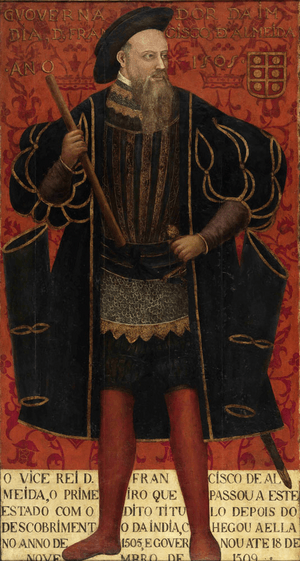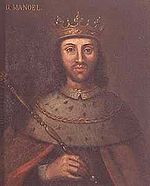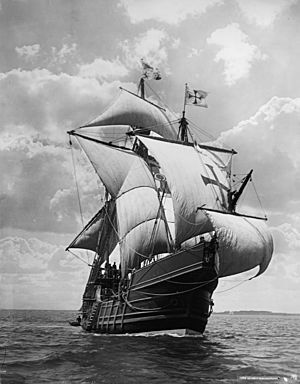Francisco de Almeida facts for kids
Quick facts for kids
His Lordship
D. Francisco de Almeida
|
|
|---|---|
 |
|
| 1st Viceroy of Portuguese India | |
| In office 12 September 1505 – 4 November 1509 |
|
| Monarch | Manuel I of Portugal |
| Preceded by | Tristão da Cunha (designate; never took office) |
| Succeeded by | Afonso de Albuquerque |
| Personal details | |
| Born |
Francisco de Almeida
ca. 1450 Lisbon, Kingdom of Portugal |
| Died | 1 March 1510 (aged 59–60) Table Bay, Cape of Good Hope |
| Children | Lourenço de Almeida |
| Occupation | Soldier, explorer, viceroy of Portuguese India |
| Known for | Establishment of Portuguese naval hegemony in the Indian Ocean. |
Dom Francisco de Almeida (Portuguese pronunciation: [fɾɐ̃ˈsiʃku dɨ aɫˈmɐjðɐ]), also known as the Great Dom Francisco (around 1450 – 1 March 1510), was a Portuguese nobleman, soldier, and explorer. He was a trusted advisor to King John II of Portugal. Later, he fought in wars against the Moors and helped conquer Granada in 1492.
In 1505, he became the first governor and viceroy of the Portuguese State of India. Almeida is famous for making Portugal the main naval power in the Indian Ocean. He achieved this with his big victory at the naval Battle of Diu in 1509. Sadly, before returning to Portugal, he died in a fight with local people at the Cape of Good Hope in 1510. His only son, Lourenço de Almeida, had already died in the Battle of Chaul.
Contents
Early Life and Military Career
Francisco de Almeida was born in Lisbon, Portugal. Like many young men from noble families, he joined the military at a young age. In 1476, he took part in the Battle of Toro. He also fought in conflicts in different parts of Morocco. In 1492, he helped the Castilians in their Christian conquest of Granada.
Mission to the East
In 1505, King Manuel I of Portugal appointed Almeida as the first viceroy of Portuguese India. Almeida was in his mid-fifties at the time. He left Lisbon on March 25, 1505, with a large fleet of 22 ships. This fleet included 14 large ships called carracks and 6 smaller ships called caravels.
About 1,500 soldiers were on board. His main ship was the São Rafael, captained by Fernão Soares. The main goals of this mission were to:
- Take control of the valuable spice trade.
- Build forts along the coasts of East Africa and India.
- Make alliances with local leaders to help Portuguese trade.
- Set up trading posts.
African Conquests
Almeida's fleet sailed around the Cape of Good Hope. They then reached the African coast at Sofala and the Island of Mozambique. From there, they went north to the town of Kilwa. In July 1505, they used 8 ships to attack Kilwa, which had about 4,000 people. They conquered the town.
Kilwa had a very good harbor for large ships. So, the Portuguese decided to build a fort there. Pêro Ferreira and 80 soldiers stayed behind to build and guard it.
Later in 1505, Almeida's ships destroyed Kilwa, Barawa, and Mombasa. Mombasa was a coastal city with about 10,000 people. The Portuguese fought hard against the local Arab ruler's troops. They plundered and burned the city. The Sultan of Melinde, an enemy of Mombasa, helped the Portuguese in this attack. In the same month, a caravel from Almeida's fleet captured Zanzibar island for Portugal.
Viceroy in India

On March 25, 1505, Francisco de Almeida was officially named Viceroy of India. His main task was to build four forts on the southwestern Indian coast. These forts were planned for Anjediva Island, Cannanore, Cochin, and Quilon. He left Portugal with 22 ships and 1,500 men.
On September 13, Almeida reached Anjediva Island. He immediately began building Fort Anjediva there. On October 23, with permission from the friendly ruler Kōlattiri, he started building St. Angelo Fort in Cannanore. He left Lourenço de Brito in charge with 150 men and two ships.
Francisco de Almeida arrived in Cochin on October 31, 1505, with only eight ships left. There, he learned that Portuguese traders in Quilon had been killed. He sent his son, Lourenço de Almeida, with 6 ships. Lourenço destroyed 27 ships from Calicut in the harbor of Quilon. Almeida then settled in Cochin and made the Portuguese Fort Manuel stronger.
The Zamorin of Calicut prepared a large fleet of 200 ships to fight the Portuguese. But in March 1506, Almeida's son Lourenço stopped the Zamorin's fleet. This happened in a sea battle at the entrance to the harbor of Cannanore, known as the Battle of Cannanore. Lourenço's forces caused heavy losses to the Zamorin's fleet.
After this, Lourenço de Almeida explored the coast southwards to Colombo, in modern-day Sri Lanka. Meanwhile, the Zamorin convinced the Kōlattiri of Cannanore that the Portuguese had plans to take over. The Kōlattiri was already upset because the Portuguese had broken promises to Muslim merchants. So, the Kōlattiri joined the fight against the Portuguese. They besieged Fort St. Angelo in the Siege of Cannanore.
In 1507, Almeida's mission got stronger when Tristão da Cunha's ships arrived. However, Afonso de Albuquerque's ships had separated from Cunha's. Albuquerque was conquering territories on his own to the west.
In March 1508, an Egyptian fleet attacked the Portuguese. This fleet was led by Amir Husain Al-Kurdi of the Mamluk Egyptian kingdom. They defeated Lourenço de Almeida's ships at Chaul in the Battle of Chaul. Lourenço de Almeida was killed in this battle. This caused the Portuguese to temporarily pull back from Indian waters.
Afonso de Albuquerque arrived at Cannanore at the end of 1508. He announced that the King had secretly made him governor to replace Almeida. Almeida, wanting to get revenge for his son's death and free Portuguese prisoners, refused to accept Albuquerque's orders. He even arrested Albuquerque.
In 1509, Almeida became the first Portuguese to arrive by ship in Bombay. He then fought a major naval battle, the Battle of Diu, on February 3, 1509. He commanded 23 ships near the port of Diu. He won a huge victory against a combined fleet. This fleet included ships from Egypt, the Ottoman Empire, the Zamorin of Calicut, and the Sultan of Gujarat. They even had technical help from Venice and Ragusa.
Almeida's victory was very important. The Ottomans and Egyptians left the Indian Ocean. This allowed Portugal to control trade in Indian waters for over 100 years. This control lasted until the 17th century when the Dutch and English arrived. Albuquerque was released after three months when a large Portuguese fleet arrived in November 1509.
Return and Death
Almeida sailed for Portugal in December 1509. In late February 1510, his ships reached Table Bay near the Cape of Good Hope. They stopped there to get fresh water. They met the local people, the ǃUriǁ'aikua (also called "Goringhaiqua").
After some friendly trading, some of Almeida's crew visited the local village. They tried to steal some of the locals' cattle. Almeida allowed his captains to return to the village on March 1, 1510. They raided the cattle herd. Almeida waited for his men a short distance from the beach.
However, the landing boats had been moved, leaving the Portuguese without a way to retreat. The ǃUriǁ'aikua saw this chance to attack. During the attack, Almeida and 64 of his men died. This included 11 of his captains. Almeida's body was found that afternoon and buried on the shore of what is now Cape Town.

See also
 In Spanish: Francisco de Almeida para niños
In Spanish: Francisco de Almeida para niños
- Lourenço de Almeida, his son
- 7th Portuguese India Armada (Almeida, 1505)
- Chronology of European exploration of Asia



